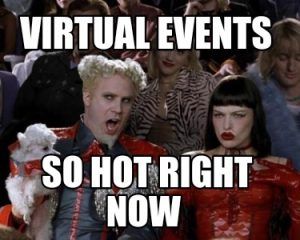3 Lessons from 4 Years of Running Virtual Developer Events
 Brian RinaldiDeveloper Experience Engineer
Brian RinaldiDeveloper Experience Engineer
LaunchDarkly
Since the start of 2020, almost everything that was once “in real life” (IRL) has gone virtual. For most of us, our offices have closed, so meetings and water cooler chats are online. We attend digital conferences. We set up our personal friends and family gatherings on our work Zoom accounts. Even as we thankfully transition into a post-pandemic year, many of these virtual aspects of our lives are likely to remain a mainstay.
However, this was not the case back in August 2017, when I started my foray into running virtual developer events on what is now cfe.dev. Since then, CFE.dev has hosted more than 100 online events – twice monthly meetups plus occasional virtual workshops and even multi-day online conferences.
At the time, the cards were stacked against a purely-online model. Back then, Meetup.com didn’t allow non-IRL meetups to be listed on their site – all events had to have a physical location. A majority of event management and ticketing platforms were the same. Obviously, that has changed since last year.
In this post, I want to talk about some of the lessons I’ve learned over the course of 4 years of building and organizing a virtual community around meetups, conferences and workshops on cfe.dev. I have not always succeeded, so these lessons are drawn from both my successes and failures. As the pandemic hopefully begins to come to an end and we adjust to our new “normal,” perhaps you’re considering keeping your activities online permanently or on the other hand, weighing whether to move them offline, I hope that the lessons I share might help guide you in making the right decisions.
Lesson #1: Virtual Events can Be Great!

Maybe you’re skeptical. You might be saying to yourself, “Of course you think virtual events are great, Brian – you run them!” But the thing is, I was skeptical too! I actually started cfe.dev with the intention of running offline, in-person meetups and conferences. I only started doing online events as a way to build the “brand” while I programmed IRL ones.
That didn’t happen (for the most part). Instead what happened was, I went from being a skeptic to (somewhat of) a believer. Surprisingly, attendees were always engaged and active, and seemingly enjoyed and learned a lot from them. They didn’t just passively sit in front of their screens, they would chat with each other, ask the speaker questions, and interact with the community as a whole. In the end, I came around to the idea that virtual events offer something more valuable than just being a poor replacement for IRL events.
So why the caveat that I was “somewhat of a believer”? That leads to Lesson 2.
Lesson 2: Virtual Events are Really Easy to Get Wrong
If you’ve ever run IRL events or conferences, you’d probably agree that, while they’re logistically complicated, they’re also extremely rewarding. In my experience, even when I thought an event was a failure for whatever reason, the feedback from the attendees, either verbal or via formal feedback surveys, said otherwise. Making real, personal connections can make up for any rough edges from an attendee perspective.

This isn’t the case for a virtual event. If an event isn’t captivating or interactive in some way, attendees will disengage and do other things or leave entirely. If you’ve attended an online event over the past year, you’ve probably noticed that unfortunately, it’s easier to build an underwhelming virtual event than a worthwhile one.
The first mistake organizers tend to make is focusing too much on trying to replicate IRL events. From all-day sessions, to hallway tracks and expos for sponsor booths, in my personal opinion (and from what I’ve heard from sponsors), those experiences simply don’t translate online.
- All-day events, even with the coffee chats and breakout sessions, were already rough when they were in-person. They’re even more exhausting when you’re stuck in front of a screen all day with headphones on. For online events, four hours a day is a sweet spot, but also consider spreading it out across days or even weeks. I’d say 6 hours, including breaks and “lunch,” is the max you should attempt.
- Don’t rely on chat to replace human networking as they can be overly lively, especially at large events. Chat is important, and you should encourage and facilitate chat activity, but it generally functions more like a Twitter feed of attendees’ stream of consciousness and questions rather than a real conversation.
- Sponsor booths and expos seem to rarely draw much activity, at least without excessively generous incentives. I suggest avoiding these things and supporting sponsors in other ways such as incorporating them into parts of the live event, running videos between sessions, or offering CTAs that lead to activities outside the event. It’s not always easy to make these events work perfectly for sponsors, you’ll have to find creative ways of meeting their needs, especially if their metrics are still designed for IRL events.
One final mistake I see is focusing on production value over authenticity. In my experience, this usually leads to virtual events that are just a collection of pre-recorded videos strung together. These feel less like “events” and more like glorified YouTube playlists. It’s better, in my opinion, to risk some polish in exchange for some realness. If the presentation portion must be pre-recorded, at least bring the speaker on stage for live Q&A. Give the audience something they can’t get by watching the session recording.
…which leads me to Lesson 3.
Lesson 3: Focus On the Strengths of Virtual Events
Here are some things that make virtual events great:

- They cost less to run and attend – Sure, some software and digital events platforms can be pricey, but it still pales in comparison to the costs of venue, food, swag, travel, etc. Those lowered costs means you can make these events free or extremely low cost to attendees but still make them financially viable for yourself or your org. This also allows you to “fill the room” with more people as the price of a ticket should be less of a burden for potential attendees.
- They’re accessible to anyone, anywhere – This goes for both attendees as well as speakers. You have practically the whole world available to you (but don’t forget, time zones are a thing). This opens up opportunities to get the best speakers and attendees from places that previously might have been infeasible from a cost perspective.
- They offer alternative ways to interact – Of course, you won’t get the same 1:1 interaction as you would at an IRL event, but online events unlock different kinds of 1:many set-ups that would otherwise logistically be difficult or impossible to organize offline. For instance, I’ve found that audience participation via live Q&A or “fireside chats” work great online, but often fail in-person. You can incorporate content formats or drop links in ways that would be difficult offline. You now can invite attendees “on stage” easily without pausing programming to get them mic’d up. Plus, recording in-person sessions require careful planning in advance, and are time-consuming and expensive to produce. Now with the click of a button, you can produce and provide awesome video resources for your attendees almost immediately after the event.
If you keep all of these strengths and common pitfalls of virtual events in mind, and take advantage of the lessons from organizers (like myself) who have been doing this before the absence of IRL activities, you can build a strong and long-lasting online events and community strategy.
Brian Rinaldi is a Developer Advocate at StepZen with over 20 years experience as a developer for the web. Brian is actively involved in the developer community running meetups via CFE.dev and Orlando Devs. He’s the editor of the Jamstacked newsletter and co-editor of Mobile Dev Weekly and co-author of The Jamstack Book from Manning. You can learn more and connect with him on Twitter @remotesynth.
Subscribe to Heavybit Updates
You don’t have to build on your own. We help you stay ahead with the hottest resources, latest product updates, and top job opportunities from the community. Don’t miss out—subscribe now.
Content from the Library
Generationship Ep. #34, Together with Nathen Harvey
In episode 34 of Generationship, Nathen Harvey brings data, humor, and heart to a conversation about AI, DevOps, open source, and...
How It's Tested Ep. #14, Quality Culture with Rosie Sherry of Ministry of Testing
In episode 14 of How It’s Tested, Eden Full Goh speaks with Rosie Sherry, founder of the Ministry of Testing, about her journey...
Authentic Communities in the Era of AI
In this special Speaker Series event, our panel explores the implications of AI on the effort and ability to build authentic...